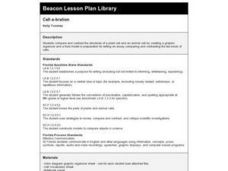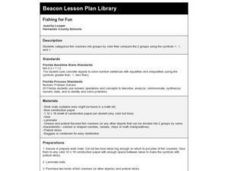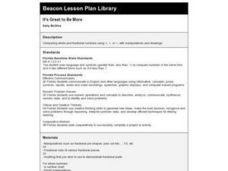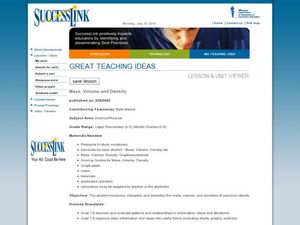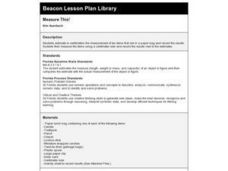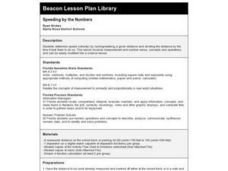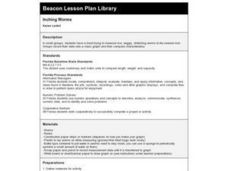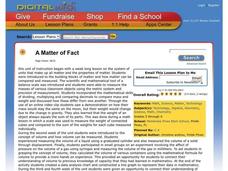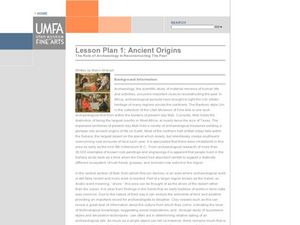Curated OER
Cell-a-bration
Fifth graders study the structures of a plant cell and animal cell. They create a graphic organizer and a food model. Finally, they write an essay comparing and contrasting plant and animal cells.
Curated OER
Fishing For Fun
Second graders categorize fish crackers into groups by color and compare the two groups using the symbols <, =, and >. They use concrete objects to solve number sentences with equalities and inequalities.
Curated OER
Position and Piecewise Velocity
Students solve piecewise functions. In this precalculus lesson, students model real life scenarios using velocity and piecewise. They create velocity graphs and find the beginning and end position of an object.
Curated OER
It's Great to Be More
Students compare whole and fractional numbers using <, >, or =, with manipulatives and drawings.
Curated OER
Density Destiny
Sixth graders measure and investigate the densities of several objects. They, in teams, determine the mass and volume of each of the 5 objects and record the measurements in the data table.
Curated OER
Mass, Volume and Density
Students compare and contrast the mass, volume, and density of various objects. They use a triple beam balance, measure and record the volume of a cup of water, and discuss the results.
Curated OER
Measure This!
Students estimate the measurement in centimeters for common classroom objects. They check their estimations, discuss the differences and write a paragraph summarizing the activity.
Curated OER
Essential to Autumn: Line, Shape, Color, Texture, Pattern, Rhythm, Emphasis, Movement, Balance, and Unity
Students explore the environment by learning about nature. For this art lesson, students go on a walk and find objects to help in creating a picture, or collage representing whatever season is being discussed. Students write similes...
Curated OER
Fractions in Clay
Learners represent and explain fractions as part of a set using modeling clay. They create sets of objects as specified by individual task cards.
Curated OER
Speeding By The Numbers
Students determine speed by running or walking a given distance and dividing the distance by the time it took them to do so. They record their average speed and compare it with the speeds of other moving objects.
Curated OER
Density
Pupils explore the meaning of density. In this density lesson, students use interactive whiteboards to review definitions regarding density and compare the density of selected objects.
Curated OER
Cell Types
Fourth graders create cartoon characters which compare and contrast two types of cells: nerve and muscle. Cartoon characters show how these two cells are similar, how they are different, and the relationship between the two cell types.
Curated OER
Inching Worms
Third graders have a blast trying to measure live, wiggly, stretching worms to the nearest inch. Groups record their data onto a class graph and then compare characteristics. They share their findings with the rest of the class. Fun lesson!
Curated OER
Make Your Own Thermometer
Students recognize the concept of temperature, including degrees, and the melting and freezing process. In this 1st - 2nd grade lesson plan, students identify the temperature of various objects, as well as create their own paper...
Curated OER
How Do I Measure Up?
Students measure and record weights and heights and compare to others in the class as they find out more about their bodies.
Curated OER
The Magic School Bus Lost in Space
Pupils identify the planets by making two models of the Solar System. They create a model that shows the order of the planets and a model that shows the planets sizes as compared to one another. They may write about the planet they like...
Teach Engineering
Let's Get it There Fast
Are planes the best shipping method? Using maps, pupils determine the fastest mode of transportation between two cities. Given a list of items to ship, groups decide the best shipping method to finish the 18th segment of a 22-part unit.
Curated OER
A Matter of Fact
Young scholars design their own Science experiment. For this science experiment lesson students create a hypothesis related to matter and test it. They displayed their data in a graph.
Curated OER
Ancient Origins: The Role of Archaeology in Reconstructing the Past
Students read information about the ancient origins of art and archaeology with a focus on the Malian culture. In this art origins lesson, students read background information for the topic and compare ancient and contemporary objects....
Curated OER
Potential & Kinetic Energy
Young scholars test different sized marbles and how fast they can go. In this energy lesson plan, students test different sized marbles going down an incline. They predict which would have the most potential and kinetic energy. After the...
Curated OER
Seeing Interference Fringes with a Telescope
Students construct an interferometer using a simple telescope. In this physics lesson, students explain how light waves create the fringe patterns. They observe patterns made by different objects in the sky and compare them.
Curated OER
Sorting Sizes
Students follow a pattern. For this sorting lesson, students are given various objects and they must sort them from smallest to largest.
Curated OER
The Magic School Bus Out of this World
Students explore the craters that objects of different sizes and weights make. They use marbles, Ping-Pong balls, and aluminum-foil balls for this experiment. They investigate what would happen if they drop objects that aren't round.
Curated OER
Let's Create a Sculpture!
Pupils examine pictures to unearth the objects that were connected together to make the sculptures. Information about the artists and the history of the pieces created are discussed.
